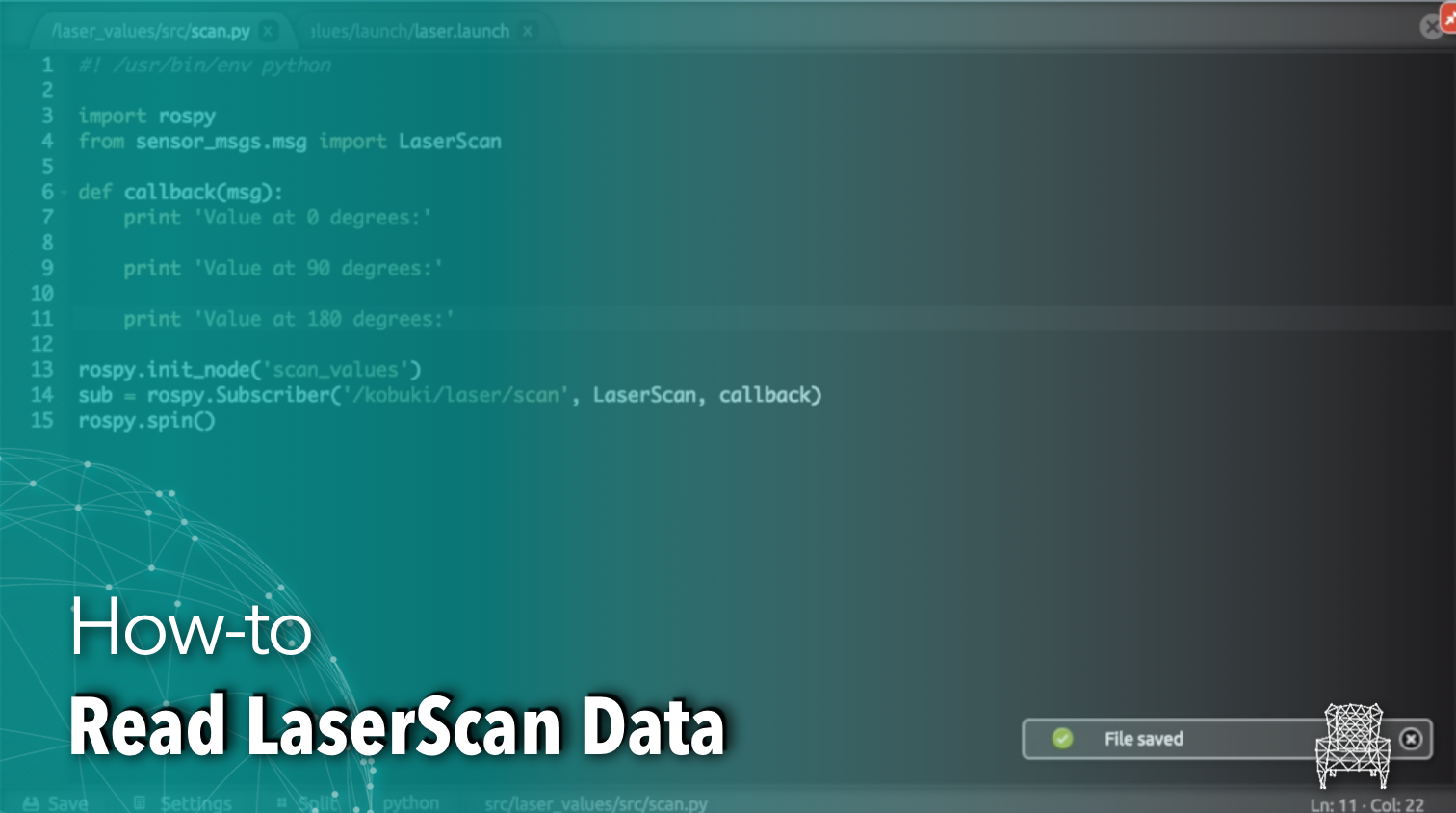About
In this video, we are going to see this question on ROS Answers – How to know the exact frame rate and angle of /scan on Turtlebot?
Step 1. Open a project on ROS Development Studio(ROSDS)
We will reproduce the question by using ROSDS. You can create a free account here.
After registration, login and add a new ROSject. Now, run the project on ROSDS and launch the Turtlebot2 by clicking the Simulation button.
Step 2. Read LaserScan data
The simulation is up and running now. You can check all the topic available with the command:
$ rostopic list
The LaserScan topic is called /kobuki/laser/scan. You can type the following command into the terminal to check the topic.
$ rostopic echo /kobuki/lase/scan -n1
The -n1 flag prints the topic exactly once. You’ll get something like this.
header:
seq: 5
stamp:
secs: 2829
nsecs: 69000000
frame_id: "laser_sensor_link"
angle_min: -1.57079994678
angle_max: 1.57079994678
angle_increment: 0.00436940183863
time_increment: 0.0
scan_time: 0.0
range_min: 0.10000000149
range_max: 30.0
ranges: [inf, inf, inf, inf, inf, ....]
The following command will give you the information for the topic
rostopic info /kobuki/laser/scan
You’ll see that the topic is using the message type called sensor_msgs/LaserScan. You can further check it with the command
rosmsg show sensor_msgs/LaserScan
The command gives you the message’s structure.
std_msgs/Header header uint32 seq time stamp string frame_id float32 angle_min float32 angle_max float32 angle_increment float32 time_increment float32 scan_time float32 range_min float32 range_max float32[] ranges float32[] intensities
The angle_min and angle_max indicate the angle range(from -90 to 90 degree in this case) that the LaserScan is measuring and the ranges is an array which gives you the distance measured for each angle bin.
To explore the range value, let’s create a package.
$ cd ~/catkin_ws/src $ catkin_create_pkg laser_values rospy $ cd laser_values $ mkdir launch
Add a python script under src with the following code
#! /usr/bin/env python
import rospy
from sensor_msgs.msg import LaserScan
def callback(msg):
print len(msg.ranges)
rospy.init_node('scan_values')
sub = rospy.Subscriber('/kobuki/laser/scan', LaserScan, callback)
rospy.spin()
Normally, you’ll need to give the script permission to execute with
$ chmod +x src/scan.py
Then we create a launch file under lunch directory to launch the script
<launch>
<node pkg="laser_values" type="scan.py" name="scan_values" output="screen">
</node>
</launch>
Now you can type
roslaunch laser_values laser.launch
to launch the script. You should also see that the length of the ranges array is 720 in the 180-degree range. So if we want to read the LaserScan data on the left, in front and on the right of the robot, we can change our script a bit.
...
def callback(msg):
# values at 0 degree
print msg.ranges[0]
# values at 90 degree
print msg.ranges[360]
# values at 180 degree
print msg.ranges[719]
...
That’s all now you get the value. You can play with it to navigate the robot.
Resources related to this topic:
Edit by Tony Huang






Hi,
If the range of the laser beam is [-1.57rad: +1.57rad], why is the ranges[0] value not equal to -1.57rad?
Hi Devan,
The values at the ranges array are the values of the readings of the laser. So, the ranges[0] value is the lecture of the laser at -1.57rad (-90º), which will depend on the environment. If there is no obstacle in that direction, the value will be infinite, if there’s an obstacle at 1 meter of the laser in that direction, the value will be 1.0, etc…
Hope it clarifies your doubts!
Is there any way to increase the range from 1m? As far as I know lidars have a greater range, for instance the range of a2 rplidars is 12m
“range” is an array, to access the data of an array we use the index and the index of “range” is from 0-719. data from those -1.57-1.57 angles come and stores into that array. so just take it as an array.
Hi, do you have this video on C++ version also using catkin_make?
Thanks
Hey David,
please check our new post here:
https://www.theconstruct.ai/ros-qa-134-simple-ros-publisher-in-c/
Hi,
how do we access the scan data at previous time stamp? For instance, i would like to process the range data by comparing every two consecutive time stamps to get a displacement rate.
Many thanks.
##I think this will do the trick. please find the code below:
dk_1 = np.array([]) creating a global variable to hold previous timestamp data
def scanProcessing(msg): ### A typical callback function which gets activated or called based on the topic scan
print(“Inside scan proceesing function”)
global i, dk_1, dmin
count = 0
dk = np.array(msg.ranges)
i += 1
for k in range(len(dk)):
if dk[k] == math.inf:
dk[k] = 30.0
print(“Inf correction is completed”)
if i == 1:
dk_1 = dk
else:
##process what you want to do with the previous timestamp
## Hope its not too late
dk_1 = dk ## Assigning the current data to the previous timestamp holding variable
Hello Construct team
I am trying to plot the position of a moving object detected by a stationary robot in rviz or graphically. Can you suggest a way to do so ?
thanks in advance
Stealing the ingredients of potion of changing forms n faces
Is there any way to increase the range from 1m? As far as I know lidars have a greater range, for instance the range of a2 rplidars is 12m
HI, If i have a Lidar sensor. Can i still apply this script to get readings?
[scan_values-2] process has died [pid 5988, exit code 127, cmd /home/vboxuser/catkin_ws1/src/laser_values/src/scan.py __name:=scan_values __log:=/home/vboxuser/.ros/log/e798bb36-cf9c-11ed-b772-11f52b4f9236/scan_values-2.log].
log file: /home/vboxuser/.ros/log/e798bb36-cf9c-11ed-b772-11f52b4f9236/scan_values-2*.log
iam getting this error how to solve this